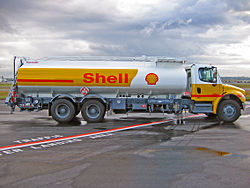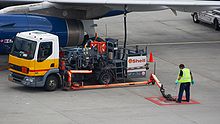Aviation fuel
|
|
This article needs additional citations for verification. (March 2010) |
Aviation fuel is a specialized type of petroleum-based fuel used to power aircraft. It is generally of a higher quality than fuels used in less critical applications, such as heating or road transport, and often contains additives to reduce the risk of icing or explosion due to high temperatures, among other properties.[1]
Most aviation fuels available for aircraft are kinds of petroleum spirit used in engines with spark plugs (i.e. piston and Wankel rotary engines), or fuel for jet turbine engines, which is also used in diesel aircraft engines.[1] Alcohol, alcohol mixtures and other alternative fuels may be used experimentally, but alcohol is not permitted in any certified aviation fuel specification.[2] In Brazil, the Embraer Ipanema EMB-202A is a version of the Ipanema agricultural aircraft with an engine converted to Ethanol.
The Convention on International Civil Aviation (ICAO), which came into effect in 1947, exempted air fuels from tax. Australia and the USA oppose a worldwide levy on aviation fuel, but a number of other countries have expressed interest. [3]
Contents |
[edit] ASTM
Fuels have to conform to a specification in order to be approved for use in type certificated aircraft. The American Society for Testing and Materials (ASTM) developed specifications for automobile gasoline as well as aviation gasoline. These specifications are ASTM D 910 and ASTM D 6227 for aviation gasoline and ASTM D 439 or ASTM D 4814 (latest revision) for automobile gasoline.[2]
[edit] Production of aviation fuel
The production of aviation fuel falls into two categories: fuels suitable for turbine engines and fuels suitable for piston engine aircraft. There are international specifications for both. Aviation gasoline, Avgas, is used in piston engine aircraft where the emphasis is on anti-knock characteristics. The fuel must meet performance guidelines for both the rich mixture condition required for higher power during take-off and the weak mixture which permits economic cruising. Jet fuel used for turbine engines must remain pumpable at low temperatures, meet definite limits in terms of density and calorific value and burn cleanly and remain stable when heated to high temperatures.[4]
Avgas is sold in much lower volumes, but to many more individual aircraft, whereas jet fuel is sold in high volumes to large aircraft operated typically by airlines, military and large corporate aircraft.[5]
[edit] Avgas
Avgas (aviation gasoline) is an aviation fuel used to power spark-ignited piston-engine aircraft. It can be distinguished from mogas (motor gasoline), which is the everyday petroleum spirit used in cars. Avgas is formulated for stability, safety, and predictable performance under a wide range of environments, and is typically used in aircraft that use reciprocating or Wankel engines. Dyes for the fuel are required in some countries:[6]
| Country | Fuel | Lead content | Status | Dye |
|---|---|---|---|---|
| Worldwide | 80/87 | Low lead | Phased out, difficult to obtain | red |
| Worldwide | 82UL | Unleaded | Not produced since 2008 | purple |
| Worldwide | 100LL | Low lead | Most commonly used aviation fuel | blue |
| Worldwide | 100/130 | 4 grams of lead per US gallon (1.1 g/l) | In process of being replaced by 100LL | green |
| Worldwide | 91/96 | Discontinued (sometimes produced for races) | brown | |
| Worldwide | 115/145 | Discontinued (mainly military use) | purple |
[edit] Jet fuel
Jet fuel is a clear to straw-colored fuel, based on either an unleaded kerosene (Jet A-1), or a naphtha-kerosene blend (Jet B). It is similar to diesel fuel, and can be used in either compression ignition engines or turbine engines.
Jet-A powers modern commercial airlines and is a mix of pure kerosene and anti-freeze and burns at temperatures at or above 49 degrees Celsius (120 degrees Fahrenheit). Kerosene-based fuels have a much higher flash point than gasoline-based fuels, meaning that they ignite at significantly higher temperatures. It is a high-quality fuel, however, and if it fails the purity and other quality tests for use on jet aircraft, it is sold to other ground-based users with less demanding requirements, like railroad engines. [7]
[edit] In use
Aviation fuel is often dispensed from a tanker or bowser, which is driven up to parked aircraft and helicopters. Some airports have pumps similar to filling stations up to which aircraft must taxi. Some airports also have permanent piping to parking areas for large aircraft.
Regardless of the method, aviation fuel is transferred to an aircraft via one of two methods: overwing or underwing. Overwing fuelling is used on smaller planes, helicopters, and all piston-engine aircraft. Overwing fuelling is similar to car fuelling — one or more fuel ports are opened and fuel is pumped in with a conventional pump. Underwing fuelling, also called single-point, is used on larger aircraft and for jet fuel exclusively. For single-point fuelling, a high-pressure hose is attached and fuel is pumped in at 40 psi and a maximum of 45 psi for most commercial aircraft. Pressures for military aircraft, especially fighters, range up to 60 psi maximum. Air being displaced in the tanks is usually vented overboard through a single vent on the aircraft. Since there is only one attachment point, fuel distribution between tanks is either automated or it is controlled from a control panel at the fuelling point or in the cockpit. A dead man's switch is also used to control fuel flow. An early use of pressure refuelling was on the de Havilland Comet and Sud Aviation Caravelle.[1]
Because of the danger of confusing the fuel types, a number of precautions are taken to distinguish between avgas and jet fuel beyond clearly marking all containers, vehicles, and piping. Avgas is treated with either a red, green, or blue dye, and is dispensed from nozzles with a diameter of 40 millimetres (49 millimetres in the USA).[8][9]
The aperture on fuel tanks of piston-engined aircraft cannot be greater than 60 millimetres in diameter. Jet fuel is clear to straw-colored, and is dispensed from a special nozzle called a "J spout" that has a rectangular opening larger than 60 millimetres in diameter, so as not to fit into avgas ports. However, some jet and turbine aircraft, such as some models of the Astar helicopter, have a fuelling port too small for the J spout, and thus require a smaller nozzle to be installed to be refuelled efficiently.
[edit] Energy content
The net energy content for aviation fuels depends on their composition. Some typical values are:[10]
- BP Avgas 80, 44.65 MJ/kg, density at 15 C is 690 kg/m3
- Kerosene type BP Jet A-1, 43.15 MJ/kg, density at 15 C is 804 kg/m3
- Kerosene type BP Jet TS-1, (for lower temperatures) 43.2 MJ/kg, density at 15 C is 787 kg/m3
[edit] Chemical composition
Aviation fuels consist of blends of over a thousand chemicals, primarily hydrocarbons (paraffins, olefins, naphthenes, and aromatics), as well as additives, such as antioxidants and metal deactivators, and impurities. Principal components include n-heptane and isooctane. Like other fuels, blends of aviation fuel used in spark-ignited piston-engined aircraft are often described by their octane rating.
[edit] Safety precautions
Any fuelling operation can be very dangerous, and aviation fuel has a number of unique characteristics which must be accommodated. As an aircraft flies through the air, it can accumulate a charge of static electricity. If this is not dissipated before fuelling, an electric arc can occur, which may ignite fuel vapors. To prevent this, aircraft are electrically bonded to the fuelling apparatus before fuelling begins, and are not disconnected until fuelling is complete. Some regions require the aircraft and/or fuel truck to be grounded, as well.[11]
Aviation fuel can cause severe environmental damage, and all fuelling vehicles must carry equipment to control fuel spills. In addition, fire extinguishers must be present at any fuelling operation, and airport firefighting forces are specially trained and equipped to handle aviation fuel fires and spills. Aviation fuel must be checked daily and before every flight for contaminants, such as water or dirt.
Many airlines now require safety belts be left unfastened should passengers be aboard when refuelling happens.[citation needed]'
[edit] See also
[edit] References
- ^ a b Oil and Gas IQ,. "Aviation Fuel". http://www.oilandgasiq.com/glossary/aviation-fuel/. Retrieved 10 May 2012.
- ^ a b FAA,. "FAA Ethanol Safety Document". http://www.energy-consumers-edge.com/faa-ethanol-safety.html. Retrieved 10 May 2012.
- ^ Lily's General Trading P.E.,. "Petroleum and Derivatives". http://www.lilysgeneraltrading.com/ProductsInformation/PetroleumandDerivatives/tabid/66/Default.aspx. Retrieved 10 May 2012.
- ^ Air Bp,. "Avgas vs Jet Fuel". http://www.bp.com/sectiongenericarticle.do?categoryId=4503818&contentId=57639. Retrieved 10 May 2012.
- ^ Sergeant Oil & Gas Co Inc. "Aviation gasoline". http://www.aviation-fuel.com/. Retrieved 10 May 2012.
- ^ CSG,. "Aviation Fuel - AvGas Information Aviation Gasoline". http://www.csgnetwork.com/avgas.html. Retrieved 10 May 2012.
- ^ U.S. Centennial of Flight Commission. "Aviation Fuel". http://www.centennialofflight.gov/essay/Evolution_of_Technology/fuel/Tech21.htm. Retrieved 10 May 2012.
- ^ CSGNetwork.com. "Aviation Fuel-AvGas Information Aviation Gasoline". http://www.csgnetwork.com/avgas.html. Retrieved 10 May 2012.
- ^ Shell.com,. "AvGas Grades and Specifications". http://www.shell.com/home/content/aviation/products/fuels/types/avgas/. Retrieved 10 May 2012.
- ^ Air BP. BP Products handbook Retrieved 2008-09-13
- ^ http://www.cityofgustine.com/Rulesandregulations.pdf
[edit] External links
- History of jet fuels (by AirBP)
- Aviation Fuels Technical Review (by Chevron Global Aviation)
- "Shauck and his wife flew a single-engine airplane across the Atlantic Ocean in 1989, using 100% Ethanol". http://www.ethanolmt.org/php/novdec05.php.
- Air NZ sees biofuel salvation in jatropha
- Kurfürst - Resource on Messerschmitt Bf 109 performance. Documents on World War II German aviation fuel.
- World Jet Fuel Specificiations 2008 handbook
- Shell Aviation Fuels Handbook





